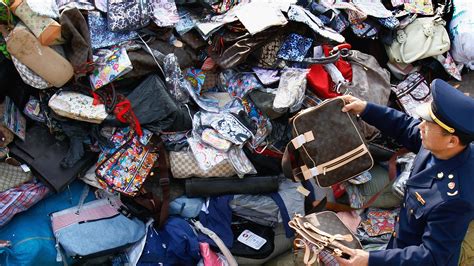fake cloths how they effect the market | effects of counterfeit clothing fake cloths how they effect the market Recent site closures include those selling fake Christian Louboutin pumps, Vivienne Westwood jewellery, Mulberry leather wallets and Pandora bracelet charms. The sites are filled with stolen brand imagery and logos, .
the fourth letter of the English alphabet, a consonant. any spoken sound represented by the letter D or d, as in dog, ladder, ladle, or pulled. something having the shape of a D . a .
0 · why are counterfeits bad
1 · fashion industry counterfeit products
2 · effects of counterfeit products
3 · effects of counterfeit clothing
4 · counterfeit fashion brands
5 · counterfeit clothing meaning
6 · counterfeit clothing industry
7 · counterfeit clothing
It’s usually the 3-digit code on the back of a credit card. Cvv in deep web though, refers to credit card records, including the cardholder’s name, address, credit card number and expiry date, and CVV code. Cvvs are usually bought in a cvv shop for a price. Some websites operate as platforms where users can buy them off for a few dollars.
Counterfeit fashion, often synonymous with knockoff products, refers to manufacturing the replica of products with the intent to deceive the buyer. Fashion clothing retailers such as Inditex (e.g., .
For many businesses, counterfeits can mean loss in revenue and damage to customer trust and reputation. However, in some cases they can actually put health and safety .
In 2020 alone, the fashion industry lost more than billion due to fake products; while the global counterfeiting industry was expected to hit .2 trillion by 2022; The most counterfeited products are clothing, followed by . Despite extensive and expensive enforcement efforts by nearly all luxury and fashion brands, the counterfeit trade is positively booming with the . More than 25% of consumers have unwillingly purchased non-genuine goods online – and according to a test by the U.S. Government Accountability Office, it was found . Recent site closures include those selling fake Christian Louboutin pumps, Vivienne Westwood jewellery, Mulberry leather wallets and Pandora bracelet charms. The sites are filled with stolen brand imagery and logos, .
why are counterfeits bad
Replicas are growing in popularity among young consumers. According to a Red Points poll, nearly 20% of survey participants 18 to 29 said they had knowingly bought a fake product.
Products purchased directly via social media are twice as likely to be fake as those bought through other e-commerce channels, according to Certilogo. House of Sunny is making its designs more intricate to deter . Even with companies’ hefty budgets for brand protection efforts, the market for fakes continues to rise, driven by a confluence of factors – from the increased availability and ease with which these goods can be purchased to .
Fashion products such as clothes and shoes are among the most replicated items. Marketplaces such as Amazon and Facebook are working to prevent the sale of counterfeit products. Fake products can result in health hazards, loss of image, and slow growth.Counterfeit fashion, often synonymous with knockoff products, refers to manufacturing the replica of products with the intent to deceive the buyer. Fashion clothing retailers such as Inditex (e.g., their brand Zara) or ASOS are long known to sell the knockoffs of the other brand’s products.
fashion industry counterfeit products
For many businesses, counterfeits can mean loss in revenue and damage to customer trust and reputation. However, in some cases they can actually put health and safety at risk.
In 2020 alone, the fashion industry lost more than billion due to fake products; while the global counterfeiting industry was expected to hit .2 trillion by 2022; The most counterfeited products are clothing, followed by cosmetics and personal care, watches and jewelry, handbags and luggage. Despite extensive and expensive enforcement efforts by nearly all luxury and fashion brands, the counterfeit trade is positively booming with the market for counterfeit clothing, textiles, footwear, handbags, cosmetics, and watches amounting to a whopping 0 billion – and growing – as of last year. More than 25% of consumers have unwillingly purchased non-genuine goods online – and according to a test by the U.S. Government Accountability Office, it was found that two of every five brand name products they bought . Recent site closures include those selling fake Christian Louboutin pumps, Vivienne Westwood jewellery, Mulberry leather wallets and Pandora bracelet charms. The sites are filled with stolen brand imagery and logos, alongside heavy discounts and suggestions of "outlet" or "last-season stock."
effects of counterfeit products
Replicas are growing in popularity among young consumers. According to a Red Points poll, nearly 20% of survey participants 18 to 29 said they had knowingly bought a fake product. Products purchased directly via social media are twice as likely to be fake as those bought through other e-commerce channels, according to Certilogo. House of Sunny is making its designs more intricate to deter counterfeiters.
Even with companies’ hefty budgets for brand protection efforts, the market for fakes continues to rise, driven by a confluence of factors – from the increased availability and ease with which these goods can be purchased to an overarching evolution in how consumers have come to view counterfeits. Put simply, the counterfeit game is changing. Fashion products such as clothes and shoes are among the most replicated items. Marketplaces such as Amazon and Facebook are working to prevent the sale of counterfeit products. Fake products can result in health hazards, loss of image, and slow growth.
Counterfeit fashion, often synonymous with knockoff products, refers to manufacturing the replica of products with the intent to deceive the buyer. Fashion clothing retailers such as Inditex (e.g., their brand Zara) or ASOS are long known to sell the knockoffs of the other brand’s products.
For many businesses, counterfeits can mean loss in revenue and damage to customer trust and reputation. However, in some cases they can actually put health and safety at risk. In 2020 alone, the fashion industry lost more than billion due to fake products; while the global counterfeiting industry was expected to hit .2 trillion by 2022; The most counterfeited products are clothing, followed by cosmetics and personal care, watches and jewelry, handbags and luggage. Despite extensive and expensive enforcement efforts by nearly all luxury and fashion brands, the counterfeit trade is positively booming with the market for counterfeit clothing, textiles, footwear, handbags, cosmetics, and watches amounting to a whopping 0 billion – and growing – as of last year. More than 25% of consumers have unwillingly purchased non-genuine goods online – and according to a test by the U.S. Government Accountability Office, it was found that two of every five brand name products they bought .

Recent site closures include those selling fake Christian Louboutin pumps, Vivienne Westwood jewellery, Mulberry leather wallets and Pandora bracelet charms. The sites are filled with stolen brand imagery and logos, alongside heavy discounts and suggestions of "outlet" or "last-season stock." Replicas are growing in popularity among young consumers. According to a Red Points poll, nearly 20% of survey participants 18 to 29 said they had knowingly bought a fake product. Products purchased directly via social media are twice as likely to be fake as those bought through other e-commerce channels, according to Certilogo. House of Sunny is making its designs more intricate to deter counterfeiters.
effects of counterfeit clothing

counterfeit fashion brands
counterfeit clothing meaning
Whisper quiet sound levels, down to 19 dB(A). Can be controlled remotely with the Daikin Comfort Control App, adaptor required. *2 Coverage. 250 - 1,200 sq/ft View. Daikin OTERRA Wall Mount Efficiency. Up to 21 SEER2 | Up to 10 HSPF2 Features. Now available with R-32 or R-410A. Perfect for additions or seasonal cooling and heating
fake cloths how they effect the market|effects of counterfeit clothing

























